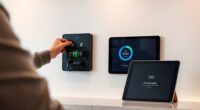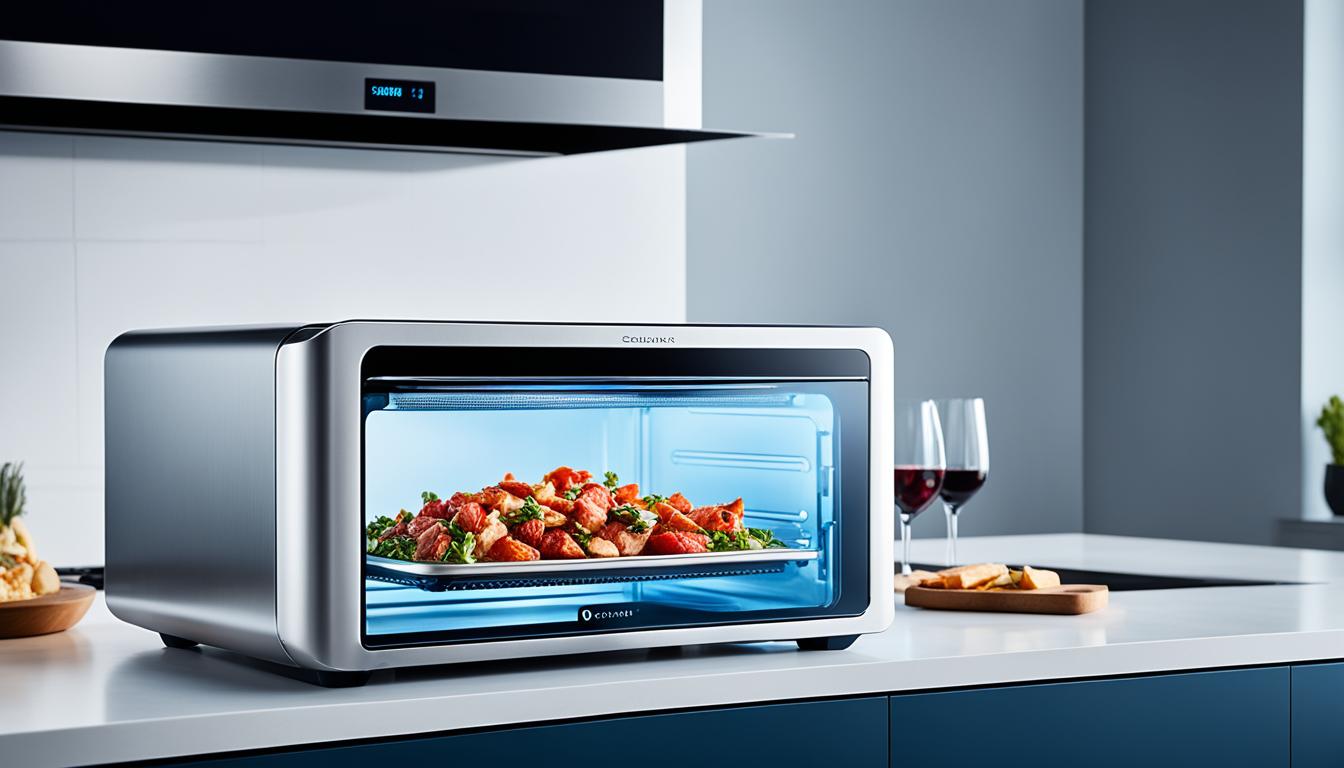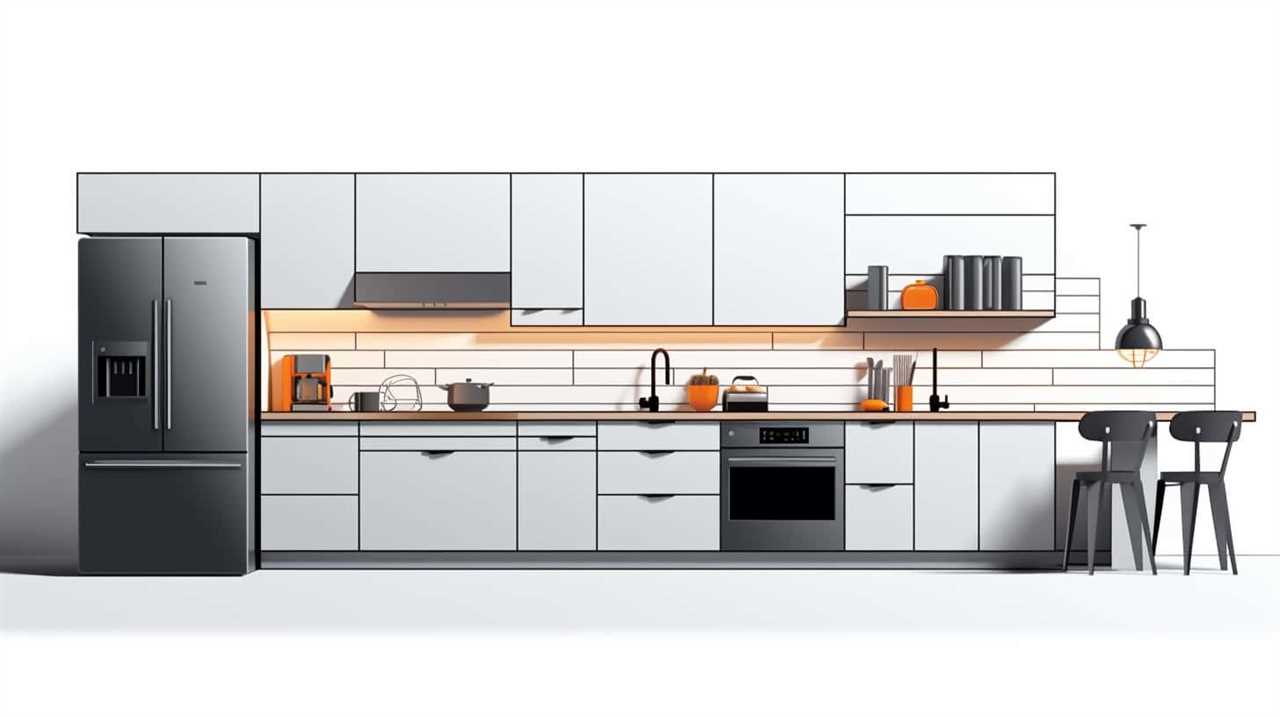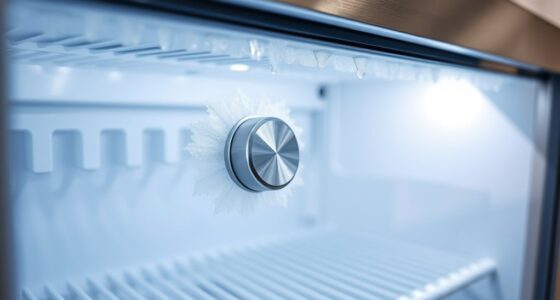To optimize Matter scenes and automations for appliances, focus on creating intuitive routines that sync devices effortlessly, like morning wake-up or bedtime scenes. Use voice commands and control platforms for easy management, ensuring your devices are Thread-enabled for reliable connectivity. Prioritize secure setup with manufacturer protocols and regular updates. Incorporate energy-efficient automations to reduce costs while maintaining comfort. With proper planning, you’ll discover how to make your smart home run smoothly and securely at all times.
Key Takeaways
- Use Matter-compliant devices to ensure seamless interoperability across appliances and automation systems.
- Create customized scenes that automate multiple appliances simultaneously for streamlined home management.
- Schedule automations during off-peak hours and incorporate sensor triggers for energy efficiency.
- Regularly update device firmware to maintain security, compatibility, and access to new features.
- Leverage user profiles and voice commands for personalized and intuitive automation experiences.
Leveraging Scenes to Simplify Daily Routines

Scenes in smart homes enable you to streamline your daily routines by automating multiple device actions with a single command. Imagine waking up to a scene that gradually raises your roller shutters and lights, mimicking a natural sunrise to help you wake up naturally. Your smart coffee machine starts brewing automatically, saving you time and ensuring fresh coffee. The thermostat adjusts to a cozy temperature, especially in colder months, making mornings more comfortable. Integration with smart speakers delivers personalized briefings, including weather, news, and your schedule. You can customize different morning scenes for each household member, tailoring the experience to individual preferences. These scenes reduce manual effort and help you start your day smoothly, effortlessly syncing your environment with your routine. Scenes can be scheduled or triggered by sensors, ensuring your home responds automatically to your presence and preferences. Incorporating device interoperability enhances the effectiveness of automation, creating a seamless smart home experience. Additionally, standardized protocols facilitate smoother communication between diverse devices, improving overall reliability and user satisfaction.
Automations for Energy Efficiency and Comfort

Smart home automations go beyond simple scenes by actively optimizing your energy use and enhancing comfort. Automated thermostats learn your habits and adjust temperatures accordingly, saving up to 12% on heating and cooling costs annually. They incorporate weather forecasts and occupancy data, optimizing HVAC operation and supporting zoning to prevent energy waste in unoccupied rooms. Additionally, engine tuning can optimize engine efficiency and responsiveness, paralleling how smart systems fine-tune home performance. Integrated with other devices, they can lower heating when windows are open or when you’re away. Automated lighting adjusts brightness based on motion and natural light, reducing energy use by up to 30%, with controls for dimming and color tuning for comfort. Appliances can be scheduled during off-peak hours or in response to demand signals, while energy storage systems balance solar production and consumption, maximizing efficiency and reducing reliance on grid power. Energy savings are further enhanced by AI-driven systems that adapt to user behavior and environmental conditions, ensuring smart energy management for optimal performance and sustainability.
Prioritizing Thread-Enabled Devices in Your Network
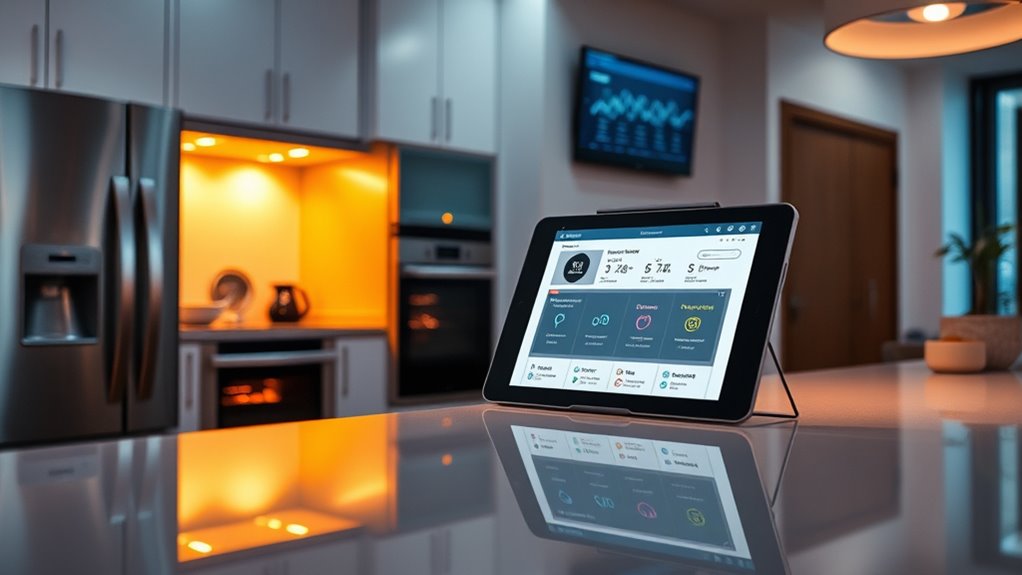
Prioritizing Thread-enabled devices in your network enhances overall stability and responsiveness. By selecting these devices, you leverage their self-healing mesh network, which reroutes traffic if a device fails, ensuring continuous connectivity. Mains-powered Thread devices act as repeaters, strengthening the network and reducing dropped connections. With IP-based communication, Thread eliminates the need for dedicated hubs, simplifying setup and expanding coverage. Adding more Thread-enabled appliances improves reliability and minimizes latency, vital for real-time controls like HVAC and security. To visualize, consider this:
| Benefit | Explanation |
|---|---|
| Mesh Redundancy | Devices act as repeaters, extending coverage |
| Self-Healing Network | Traffic reroutes automatically when needed |
| Reduced Latency | Faster response times for critical appliances |
| Eliminates Hubs | Direct device-to-device communication without hubs |
Prioritizing these devices optimizes your network’s efficiency and resilience. For example, incorporating more biodiversity-focused devices can contribute to a healthier and more sustainable home environment, and understanding the self-healing capabilities of Thread networks can help you better manage your smart home ecosystem.
Using Voice Commands and Control Platforms Effectively
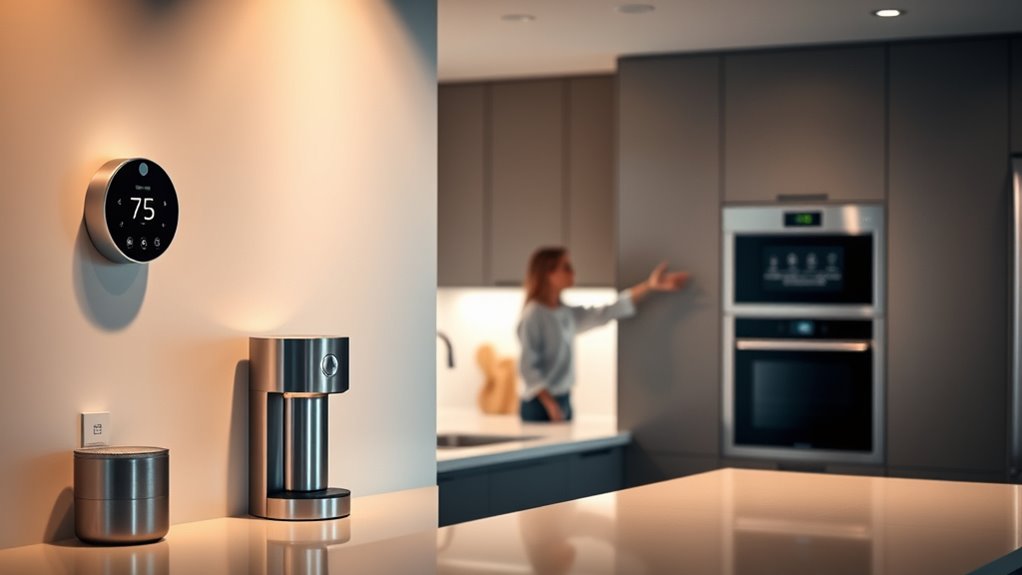
Leveraging your network’s stability with Thread-enabled devices creates a reliable foundation for voice control. To optimize voice command accuracy, guarantee your voice assistant understands natural language and context. Minimize background noise with good microphone placement and noise cancellation features, boosting recognition reliability. Take advantage of voice profiles that recognize multiple users, allowing personalized automations for each person. Regularly update your voice models through cloud-based machine learning improvements, maintaining responsiveness across diverse commands. Integrate your voice platform with your control ecosystem—supporting devices like Google Assistant or Alexa—and link with third-party services such as IFTTT to expand automation possibilities. Combining voice commands with app controls offers flexibility, while routines and schedules help streamline multi-device automation, creating a seamless, intuitive smart home experience. Additionally, ensuring your AI assistant’s trustworthiness is vital for maintaining a secure and reliable smart environment. To further enhance automation reliability, consider the network’s stability and ensure your Wi-Fi connection is robust enough to handle multiple connected devices.
Maintaining Compatibility With Manufacturer-Specific Features

Maintaining compatibility with manufacturer-specific features within the Matter ecosystem requires balancing adherence to standardized protocols with preserving unique device capabilities. You’ll want to follow the core Matter standards to guarantee interoperability across brands, but also leverage manufacturer extensions and proprietary APIs to retain advanced functions. Firmware updates play a key role, allowing devices to support Matter while maintaining special features, often through firmware or protocol bridges that translate between protocols like Zigbee and Matter. Certification by the Connectivity Standards Alliance (CSA) enforces core compliance while permitting manufacturers to include additional commands and attributes. To keep your devices functioning at their best, it’s essential to stay current with firmware updates and understand how protocol-specific nuances influence feature availability, ensuring your appliances retain their unique capabilities within the Matter framework. Additionally, understanding the compatibility standards helps in troubleshooting and optimizing device performance across different manufacturers.
Best Practices for Secure and Reliable Device Setup

Secure and reliable device setup is essential for protecting your smart home ecosystem from unauthorized access and ensuring consistent performance. Begin by using Bluetooth Low Energy (BLE) for initial discovery and onboarding, as it offers simplicity and enhanced security. Authenticate devices through QR codes or numeric setup codes, and verify your setup device is connected to the same network and internet to validate certificates and update compliance data. Perform secure handshakes to transfer network credentials automatically, preventing unauthorized access. Confirm that transport technologies like Wi-Fi, Thread, Ethernet, and BLE are certified for secure communication. Use cryptographic credentials and a Distributed Compliance Ledger (DCL) to verify device authenticity. Deploy devices on secured networks with WPA3 or Thread security, and monitor traffic for anomalies to maintain ongoing trust and integrity. Additionally, implementing regular firmware updates can help mitigate vulnerabilities associated with device effectiveness and maintain optimal security standards. Ensuring that devices are regularly tested and validated against security standards further enhances your smart home’s resilience against potential threats.
Future-Proofing Your Appliance Automation Strategy
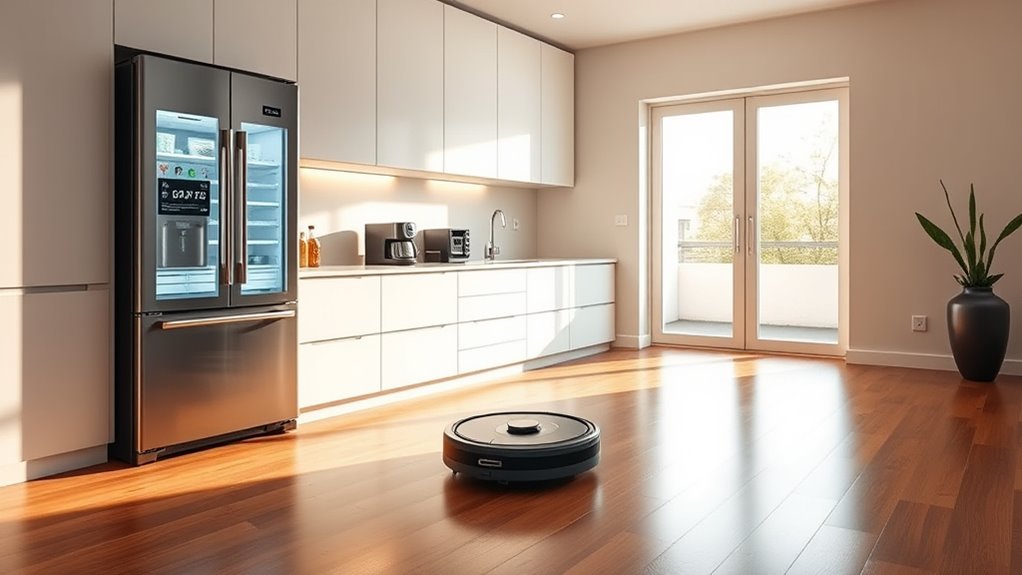
To guarantee your home automation system remains effective and adaptable as technology evolves, adopting a modular and scalable architecture is essential. By designing your system with zones or subsystems, you can upgrade individual parts independently, making future technology integration seamless. Using open-standard protocols like Matter and Thread ensures compatibility across devices from different manufacturers, preventing ecosystem lock-in. Building on a robust network backbone with enterprise-grade Wi-Fi, access points, and structured wiring supports numerous devices and reduces bottlenecks. This flexible approach allows you to add new devices and automation features without replacing core components, extending your system’s lifespan. Incorporating scalability and modularity makes your smart home future-ready, accommodating incremental upgrades aligned with emerging trends and technologies. Additionally, considering Relationships – Personality Test principles can help you maintain effective communication and resolve conflicts as your automation setup evolves over time. For example, designing your system with interoperability standards in mind ensures ongoing compatibility and simplifies future upgrades.
Frequently Asked Questions
How Do I Troubleshoot Connectivity Issues Between Matter Devices From Different Brands?
To troubleshoot connectivity issues between Matter devices from different brands, guarantee all devices are on the same Wi-Fi network, preferably 2.4 GHz if supported. Check that firmware is up-to-date on each device and confirm they’re in setup mode. Reboot devices and hubs if needed, and verify permissions on controlling apps. Also, clear stored Thread preferences and restart your network equipment to resolve any interference or configuration conflicts.
Can I Customize Automations Beyond Basic Conditions in Current Matter Platforms?
Think of your smart home as a symphony—right now, it’s playing only the basic notes. With current Matter platforms, you’re mostly limited to simple conditions, but advanced customization is like adding intricate harmonies. While standard automations stick to the basics, integrating manufacturer-specific apps or advanced bridging solutions lets you compose more complex, personalized routines. So, yes, you can go beyond simple triggers, but it often requires extra tools or apps for full orchestration.
What’s the Best Way to Update Firmware for Matter-Certified Appliances?
The best way to update firmware for Matter-certified appliances is through manufacturer-provided apps or hubs that connect your device to the OTA provider. Make certain your device is connected to a stable network, and check for updates regularly. When an update is available, download and install it promptly, following the manufacturer’s instructions. Always verify the update’s authenticity through digital signatures, and remember that rollbacks aren’t supported—you must install higher version updates.
How Do I Ensure My Existing Smart Home Devices Are Compatible With Matter?
To make certain your existing smart home devices are compatible with Matter, check if they support IP-based protocols like IPv6 and have firmware updates available. Update devices via manufacturer apps or hubs to enable Matter support. If some devices aren’t upgradable, use bridges or hubs to connect them to your Matter network. Confirm compatibility by reviewing device specifications or consulting the manufacturer’s resources to guarantee seamless integration and control.
Are There Limitations on Controlling Non-Matter Devices Through a Matter Ecosystem?
Think of controlling non-Matter devices through a Matter ecosystem as trying to tune a radio to a different station. You can bridge them, but there’s a catch: limitations exist. Some features might not be fully supported, and latency or compatibility issues could arise. Not all non-Matter devices translate perfectly, so you might experience hiccups or reduced functionality compared to native Matter devices. It’s a helpful workaround, but not a perfect solution.
Conclusion
By mastering these automation strategies, you’re set to transform your home into a smarter, more efficient space. But the real potential lies ahead—what new features and innovations will tomorrow’s appliances bring? Stay tuned, because as technology evolves, so will your ability to simplify, secure, and optimize your daily routines. The future of appliance automation is just beginning, and you won’t want to miss what’s coming next.

